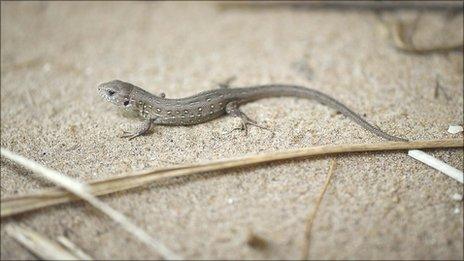Sand lizards bred at Chester Zoo return to Ynyslas
- Published

The sand lizard is one of Britain's rarest reptiles but disappeared from Wales in the middle of the 20th Century
A group of sand lizards - one of Britain's rarest reptiles - are being released back into the wild.
Once commonly found on dunes and heathland, the reptiles became endangered after the gradual destruction of their habitats.
But 46 lizards, reared at Chester Zoo, will soon be returned to their native habitats in Ynyslas, near Aberystwyth.
The zoo said they had become extinct in Wales 60 years ago.
A private breeder from Blackpool will also be releasing a further 14 lizards.
According to the Amphibian and Reptile Conservation group (ARC), the lizard was lost altogether from a number of areas, including Cheshire, Cornwall, Kent, Sussex, and north and west Wales.
Frogs, toads, lizards, snakes and newts have all been affected by the loss of their habitats, often because of building developments, changes to agricultural practice and the planting of forests.
But sand lizards and their habitats are now protected by law.
The hatcheries at Chester Zoo are designed to closely mimic the lizard's natural environment.
Protected species
Specialist keeper Isolde McGeorge said: "It's great to be involved with projects like the Sand Lizard Recovery Programme and to be able to help release these animals back into their natural habitat.
"It's the culmination of a lot of hard work and some serious commitment from an awful lot of people."
Miss McGeorge said there were a number of factors in their decline.
"But through important breeding and reintroduction programmes like this, we are slowly and surely getting them back into the areas where historically they used to live," she said.
The zoo is working on the release with a number of volunteers, as well Natural England, the Herpetological Conservation Trust, the Amphibian and Reptile Conservation charity (ARC) and the Countryside Council for Wales (CCW).
Mike Bailey, CCW senior reserve manager for Dyfi National Nature Reserve, said the Ynyslas dunes were an ideal habitat for sand lizards.
"With luck visitors will be able to see a basking sand lizard here in the future, but common lizards also occur in the dunes so careful observation will be called for," he said.
- Published6 February 2011